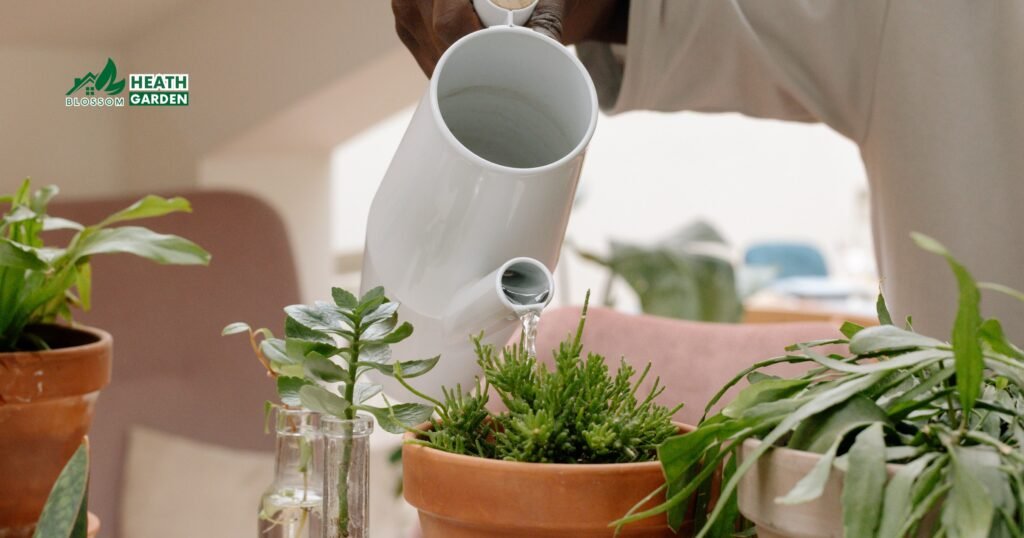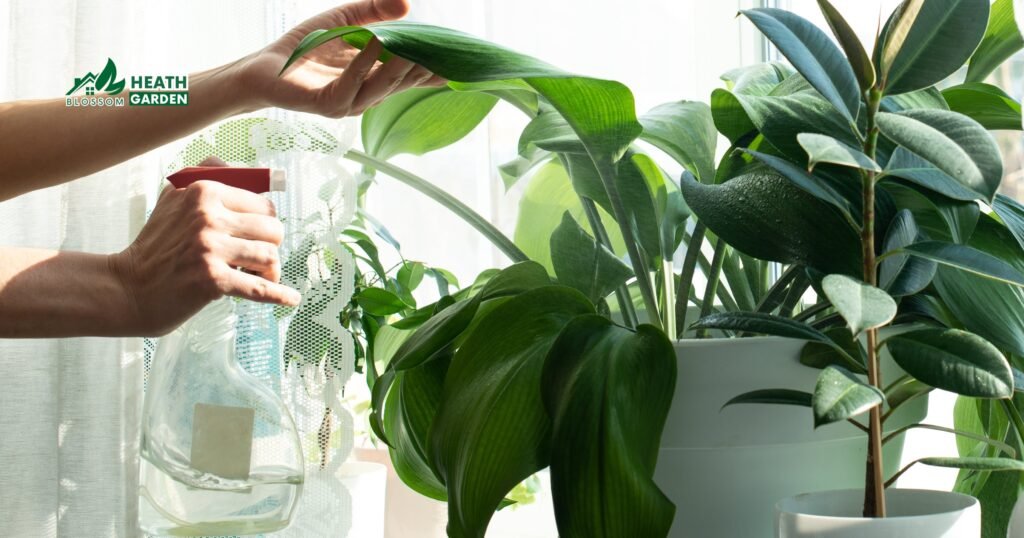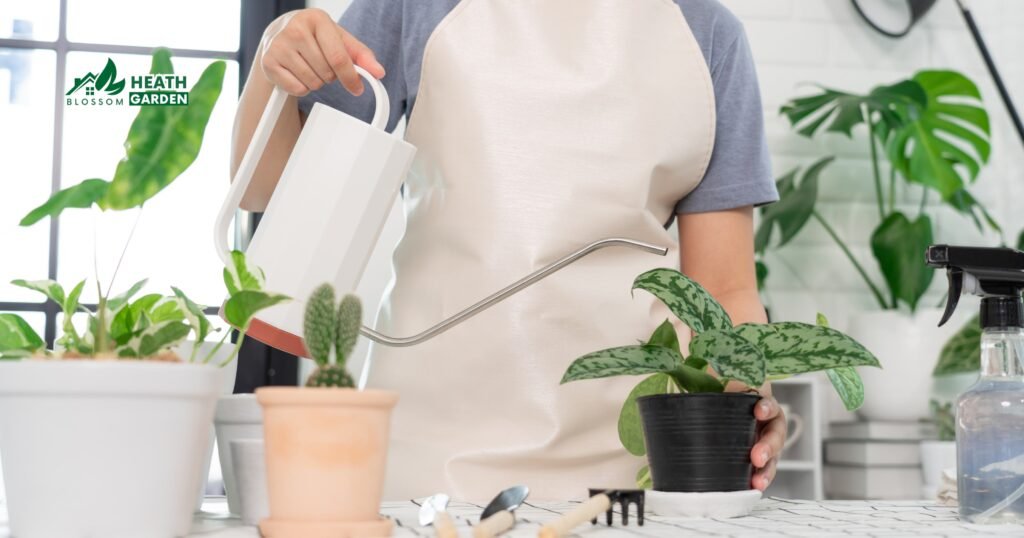- Snake plant
- African violets
- Peace lily
- Jade plant
- Ferns
- Calatheas
- Umbrella palm
- Cherry tomato
- Sword fern
What Plants Like Self-Watering Pots? Self-watering pots, also known as sub-irrigation planters, have gained popularity among novice and experienced gardeners due to their efficiency and convenience in plant care.
These innovative containers have a reservoir that holds water, allowing the plants to absorb moisture as needed. In this guide, we’ll delve into the well-suited plants for self-watering pots and explore the benefits of using this watering system.
The Ideal Candidates for Self-Watering Pots
Some plants are well-suited to self-watering pots due to their water needs and growth habits.
- Herbs: Many herbs, such as basil, rosemary, and mint, prefer consistent moisture levels, making them ideal candidates for self-watering pots.
- Houseplants: Certain indoor plants, like the peace lily or snake plant, also thrive in these pots as they prefer to dry out only partially between waterings.
- Vegetables: Small vegetables, particularly leafy varieties like lettuce and spinach, can benefit from the steady moisture supply.
Always remember the key to using self-watering pots effectively is understanding the specific watering needs of your chosen plants.

Understanding Self-Watering Pots
How Self-Watering Pots Work
- Self-watering pots consist of a water reservoir at the bottom and a growing area at the top. The reservoir is separated from the planting area by a water-permeable barrier. A wicking system, often made of wicking fabric or a wick-like material, connects the reservoir to the soil, allowing water to be drawn up by capillary action as the plant needs it.
Advantages of Self-Watering Pots
- Efficient Watering: Self-watering pots provide a consistent and efficient way to water plants, ensuring they receive the right amount of moisture without the risk of overwatering or underwatering.
- Reduced Maintenance: These pots require less frequent watering, making them ideal for busy individuals or those needing to water their plants regularly.
- Prevention of Root Rot: By avoiding waterlogging, self-watering pots help prevent root rot, a common issue in traditional pots where excess water accumulates at the bottom.
- Better Nutrient Retention: The water reservoir allows the plant to absorb essential nutrients that may leach from the soil, promoting healthier growth.

Plants Suitable for Self-Watering Pots
Herbs
- Basil: Basil thrives in self-watering pots, enjoying consistent moisture without becoming waterlogged.
- Mint: Mint appreciates the regulated watering provided by self-watering pots, promoting robust growth and flavor.
Succulents and Cacti
- Aloe Vera: Aloe Vera can thrive in self-watering pots, benefiting from controlled moisture levels that prevent overwatering.
- Sedum: Various Sedum species, known for their water-storing capabilities, do well in self-watering containers.
Leafy Greens
- Lettuce: Lettuce varieties, including romaine and butterhead lettuce, grow well in self-watering pots due to their consistent water needs.
- Spinach: Spinach is another leafy green that appreciates the even moisture levels offered by self-watering containers.
Peppers and Tomatoes
- Cherry Tomatoes: Cherry tomato plants can thrive in self-watering pots, benefitting from consistent moisture as they grow and fruit.
- Bell Peppers: Bell peppers do well in self-watering containers, ensuring they receive adequate water for healthy growth and fruiting.
e. Spider Plant (Chlorophytum comosum)
- Spider plants are well-suited for self-watering pots, as they prefer consistently moist soil without being waterlogged.
Peace Lily (Spathiphyllum)
- Peace lilies thrive in self-watering pots, appreciating the consistent moisture levels that promote lush foliage and occasional blooms.
Pothos (Epipremnum aureum)
- Pothos, a popular indoor plant, can do well in self-watering pots, benefitting from controlled watering to prevent root rot.

Tips for Using Self-Watering Pots
Monitor Water Levels
- Regularly check the water level in the reservoir to ensure it is adequately filled. Different plants have varying water requirements, so adjust the water level accordingly.
Use Well-Draining Soil
- Fill the growing area of the pot with well-draining soil to optimize the capillary action and prevent waterlogging.
Be Mindful of Plant Size
- Choose an appropriately sized self-watering pot based on the plant’s size and growth habits. Avoid overcrowding to ensure the plant can access sufficient water.
Adapt Based on Climate
- Adjust the water level and refilling frequency based on the climate and season. Plants may need more water during hot, dry periods.
Regular Cleaning and Maintenance
- Clean the reservoir and wicking system periodically to prevent blockages and maintain the functionality of the self-watering pot.
Consider Fertilizing
- Since the water in the reservoir may dilute nutrients, consider adding a balanced liquid fertilizer to ensure your plants receive adequate nutrients.
Final Thoughts
Self-watering pots provide an excellent solution for maintaining optimal plant moisture levels. You can create a thriving garden or indoor plant collection with minimal effort by understanding how these pots work and selecting suitable plants that align with their watering system. Remember to monitor water levels, choose appropriate soil, and maintain your self-watering pots to enjoy healthy and lush plants year-round. Whether beginner or experienced, incorporating self-watering pots into your gardening routine can simplify plant care and lead to flourishing greenery.
Additional Considerations for Self-Watering Pots
Seasonal Adjustments
- Be mindful that the watering needs of plants can change with the season. Plants may consume water more quickly in warmer months, requiring more frequent reservoir refills. Conversely, in cooler, dormant periods, water consumption may decrease.
Pot Placement
- The location of your self-watering pot can significantly impact a plant’s water needs. Plants in direct sunlight or heated indoor areas may require more frequent watering than those in shaded or cooler locations.
Recognizing Over and Catering Signs
- Although self-watering pots do much of the work for you, it’s still crucial to understand the signs of overwatering and underwatering. Wilting, yellow leaves, or stunted growth may indicate a watering issue that needs to be addressed.
Compatibility with Hydroponic Systems
- Some self-watering pots are compatible with hydroponic systems, allowing soilless cultivation. This can be a great option for those looking to maximize space and control their plants’ growth conditions.
Water Quality
- The quality of water used in the reservoir can affect plant health. Tap water often contains chlorine, which could be harmful to some plants. Using filtered or rainwater can be a safer alternative.
Experimentation
- Finally, feel free to experiment with different plants in your self-watering pots. While some plants may thrive, others may not adapt well, and that’s okay. This process can help you better understand the needs and preferences of various plants, enhancing your gardening skills over time.
Conclusion
What Plants Like Self-Watering Pots? To conclude, self-watering pots are a valuable tool that can greatly simplify the task of gardening. They maintain optimal moisture levels for many plant species, free up time, and reduce the guesswork in determining when to water. However, success with these pots requires understanding their operation, choosing the right plants, and making necessary adjustments based on external factors such as season and pot placement. Self-watering pots can be a game-changer with the right approach, turning even the most novice gardeners into green-thumbed experts.
FAQs
Which plants grow best in self-watering pots?
Various plants, particularly those that prefer consistent moisture, grow well in self-watering pots. Some suitable plants include cherry tomatoes, bell peppers, spider plants, peace lilies, and pothos. These pots are also ideal for growing herbs like basil and mint. Adjust the watering schedule based on the plant’s needs and environmental factors.
Are self-watering pots good for all plants?
While self-watering pots are versatile, they may only be ideal for some plants. Some plants prefer drier soil conditions and can be prone to root rot if overwatered, such as succulents and cacti. It’s essential to understand individual plant watering needs and adjust the use of self-watering pots accordingly.
Which herbs are self-watering pots?
Herbs that prefer consistent moisture, such as parsley, basil, and coriander, fare well in self-watering pots. These pots can provide the steady supply of water these herbs need for their growth. However, herbs like rosemary and thyme, which prefer drier conditions, may not thrive as well in these pots. Always adjust the water supply according to the specific needs of each herb.
Do rubber plants like self-watering pots?
Rubber plants can benefit from self-watering pots as they prefer a steady water supply but dislike sitting in water. These pots can provide the right moisture balance, reducing the risk of overwatering. However, it’s important to closely monitor the plant’s condition and adjust watering habits if signs of overwatering appear.

